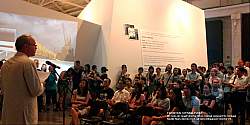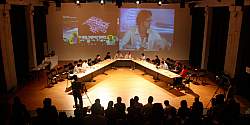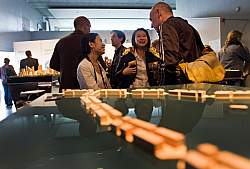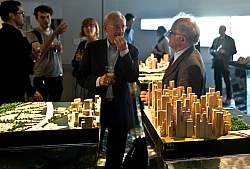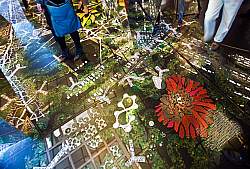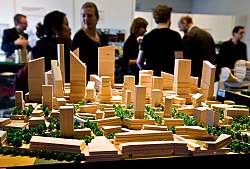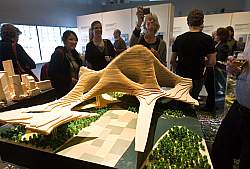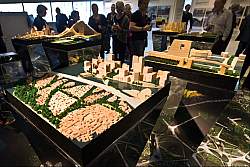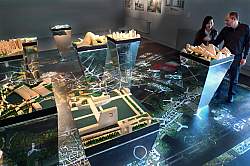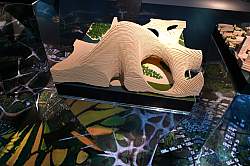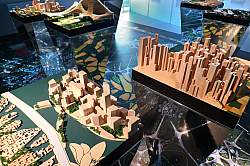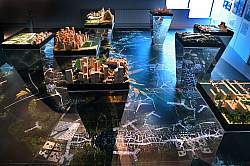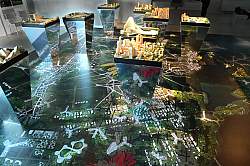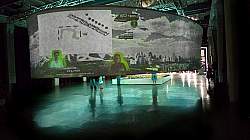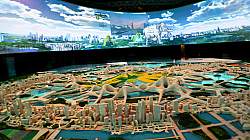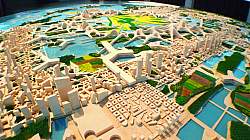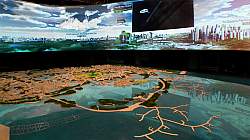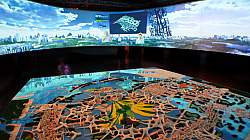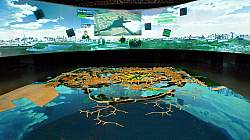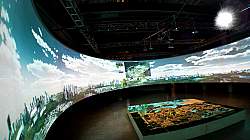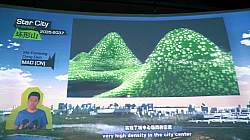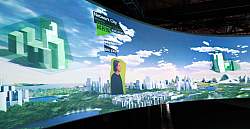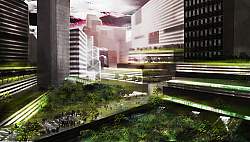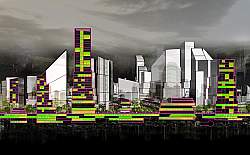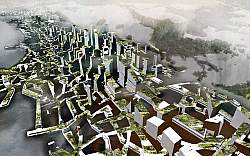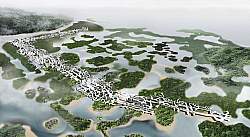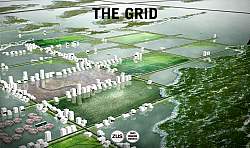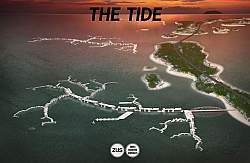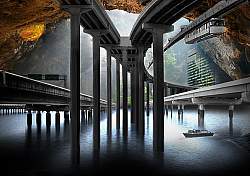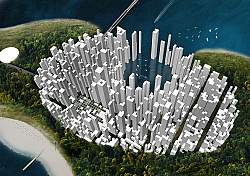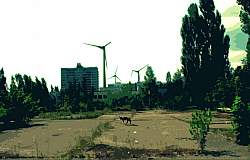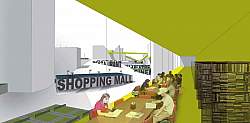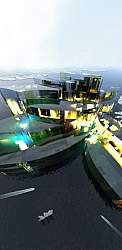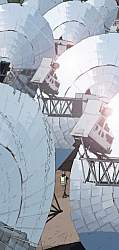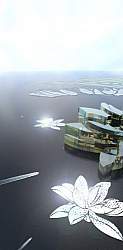B.A.R.C. - Greening the Metropolis

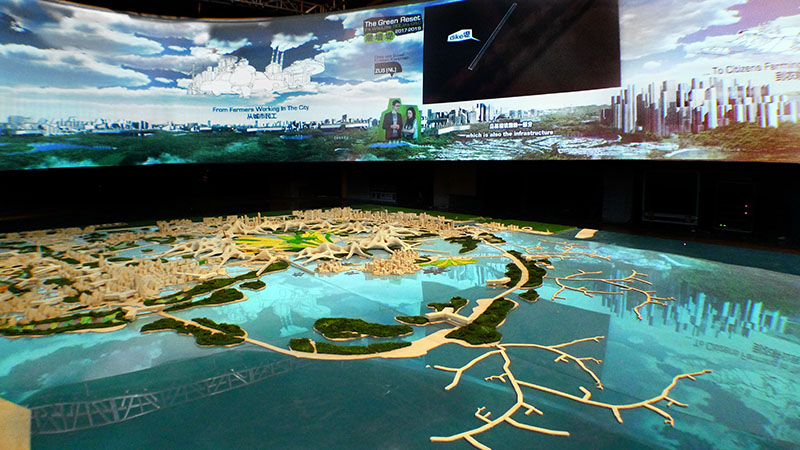
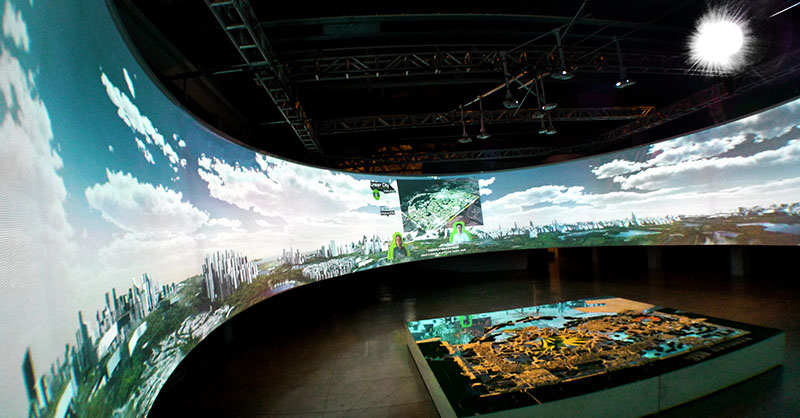
ECOCITY CAOFEIDIAN — A PLANNING RELAY
A time-based collaborative planning vision for Caofeidian Ecocity 2040 presented at the Shanghai World Expo.
Caofeidian Eco-City is China’s most ambitious response to date to the triple-challenge of explosive growth, environmental pressure, and healthy human desires for the future. However, planning a city from scratch, on a green field, and overnight are three main challenges that undermine the successful planning of sustainable cities. The Dynamic City Foundation and MARS Architects set out to develop a planning model viable within these harsh conditions. Moving beyond standard top-down planning strategies, we have developed and employed an collaborative planning method, based on evolutionary or time-based planning principles to kick start a transformation of planning process and it’s outcome. From Generic City to the Genetic City. In a unique collaboration with 5 Dutch and 5 Chinese progressive design companies a long-term growth strategy for Caofeidian was developed; not by designing all at once, but in relay; each team adding to the previous proposal. The result is a simulation of thirty years of sustainable expansion: the city as the product of an accumulation of evolving ideas, able to emulate the complexity and organic logic of a slowly maturing city.
曹妃甸生态城市是中国最有抱负的探索,它强有力的回应了中国城市面临的三个挑战:爆炸式增长,环境压力 ,人们对未来的健康需求。 但是 ,从头规划一个城市,占用绿地,迅速扩张则是破坏可持续城市成功策划的三大挑战。城市动态基金会和何新城建筑事务所着手建立一种在这种恶劣的状况中可行的规划模式。超越标准的自上而下的规划策略。我们已经发展和应用出了协同规划的方法。基于进化和基于时间的规划原则来启动规划过程的转变。他的结果是,将通用城市转化为遗传城市。这是一个由五个荷兰及五个中国的先进性的设计公司组成的独立合作团队。研究一个关于曹妃甸长期发展的策略。并非一次性设计完成,而是一个接力项目,每个团队的成果添加到早期的题案,结果是一个虚拟的三十年可持续发展,城市作为一个思想进化积累的产物,能够模拟一个缓慢成熟的城市的复杂性和有机逻辑。
Proposal in ten mutations
video links
Tsinghua School of Architecture Caofeidian Genetic City 2010-2012
Rocksteady Design Caofeidian Genetic City 2013-2015
ZUS Caofeidian Genetic City 2016-2018
Urban China / Jiang Jun Caofeidian Genetic City 2019-2021
BAU Caofeidian Genetic City 2022-2024
URBANUS Caofeidian Genetic City 2025-2027
MARS Architects Caofeidian Genetic City 2028-2030
Powerhouse Company Caofeidian Genetic City 2031-2033
MAD / Ma Yansong Caofeidian Genetic City 2034-2036
MVRDV Caofeidian Genetic City 2037-2040
.
Low resolution videos for those behind the Chinese Wall:
ZUS, Rocksteady, Tsinghua + URBANUS, BAU, Urban China + MVRDV, MAD, Powerhouse, MARS-1
UPDATE - CASLA EXHIBITION NL
GENETIC CITY CAOFEIDIAN
Ten years ago the first draft of the human genome was mapped out. The most striking thing about the sequence revealed was that it was, for the most part, completely unexpected.
According to “classical gene theory”, genes were in effect a series of blueprints for the construction of proteins — themselves the building blocks of cells and in turn of human beings. If you were to set out to design a genome, it would be a roll of architectural drawings for proteins. However, it turned out that less than 3% of the actual human genome is concerned with protein-building. As to what the other 97% does, much remains mysterious. But importantly, the one-gene-one-protein theory, like the aether, or the sun going round the earth before it, was shown to represent a profound misunderstanding of how the nature works. The lesson was this: evolution, in this case of the human genome, does not favor the “designed” solution.
This of course is not to say that evolution doesn’t achieve spectacular pieces of design. Crucially though, its approach is radically different from that of artificial design. Human designers and engineers like to strip systems down to their core elements, identify the simplest response, associate it with elegance, and then build it with a mind to minimizing cost and materials. Designs arrived at through evolution, and human genomes par excellence, pay no heed to such principles. On the contrary, they appear to be 97% junk — 97% the kinds of things that human designers would seek to “engineer out”. But in amongst all that seemingly extraneous material lurks the thing that gives the design life.
The design of cities takes place in a curious in between ground. Cities are at once the product of the artificial designs of urban planners, but equally, they are subject to evolutionary forces which shape and remold them through time. The longer cities evolve, the less engineered they appear, and the more they incorporate the kinds of complexities and counter-intuitive patterns and uses which characterize natural systems. And as cities become older and more evolved, they tend to become more adaptive. Ironically, the newest cities are frequently the ones which deal worst with modernity.
Thinking on cities has similarly undergone a form of evolution. In the 1930s when the discourse was young, it was dominated by le Corbusian ideals of the city as a “machine for living”. The 1970s tended to prefer more organic metaphors, thinking of the city as something closer to a cellular structure, like a leaf, or indeed a human body. A further iteration upon this starts to imagine the city as a being — less an organic structure than an organic entity, with a life force and an evolving will of its own. According to this logic, the city can in part be designed and engineered, but it may also fight back, and grow in directions counter to those proposed by planners.
The relevance of this thinking to China could not be more immediate. New city building is being pursued across the country at extraordinary levels of magnitude, yet an excessively engineered approach dominates, with little consideration of how the city may evolve. The clear risk is of building new cities which rapidly become old cities, and then obsolete cities. Too often the new city is conceived of as a static one-step product: something like a toothbrush, which is made to be used and then thrown away. This is rapidly problematic on two fronts. Firstly, city-building implies very considerable investor lock-in, by which the demand for financial returns (e.g. on infrastructure) requires that the city be used — at least until the investment is paid off — in something close to the specific way in which it was initially built. Cities conceived of as one-step products do not easily turn into something else. Secondly, from the sustainability perspective, cities-building is a terrifically environmentally-heavy process, in terms both of resources consumed and emissions released. Constructing and then throwing away entire cities is clearly disastrous.
But a subtler and more damning problem still is that of contemporary new cities building themselves precipitously on the wrong side of a yawning aspiration gap. The immediate demands of the hundreds of millions of China’s new urbanites are basic. For many coming into the city from poor rural environments, paved roads and tiled bathrooms represent substantial progress along the development curve. The curve however runs on, and it would be grotesquely naive to expect urban desires to stop here, or basic environments to remain satisfactory for long. The aspirations driving China’s current construction furore leap well beyond the finished products of today. There is a considerable risk that within as little as ten years, millions of new developments will be seen to be failing to deliver on the dreams which first called them into being.
Caofeidian Genetic City applies the concept of city evolution directly to the semi-paradox that is the brand new Chinese ecocity. Caofeidian itself is among China’s most ambitious current developments projects. It comprises a US$50bn combined deep water port and industrial zone (set to become one of China’s largest sites of steel production and oil refining), and a nearby ecocity to be built from scratch for over a million people. These apparent contradictions are taken as the starting point for an “evolutionary masterplan” for the Caofeidian ecocity.
Ten architecture offices (five Dutch and five Chinese) were invited to design the ecocity in relay. The first team drew a masterplan for the 2010-2013 period; the second planned on top of that for 2013-2016; the third for 2016-2019; and so on through to the final masterplan for 2040 (stage ten). This evolutionary model ensured the city developed via a process of organic emergence rather than direct design, thus allowing the city to grow toward complexity through interactions, and through a nascent inner logic of its own. Most importantly, it forced the plan to confront two things conspicuously lacking in contemporary Chinese planning: a long-term vision, and a changing future.
A city is less an engineered space than a social construct. It is built by people for people to live in and interact with each other. Accordingly, the true challenge of building a sustainable city comes less from specific technologies and points of environmental engineering than from the values attributed by societies. Green hardware will come in regardless, but the ideas that have to be dealt with are those relating to how people want and will want to use the city. For this, planning which envisages and allows for evolution — for the progression toward complexity through time — is critical. An evolved city we felt would simply that much more likely to be interesting, enjoyable, and wanted by people.
Adrian Hornsby 2010
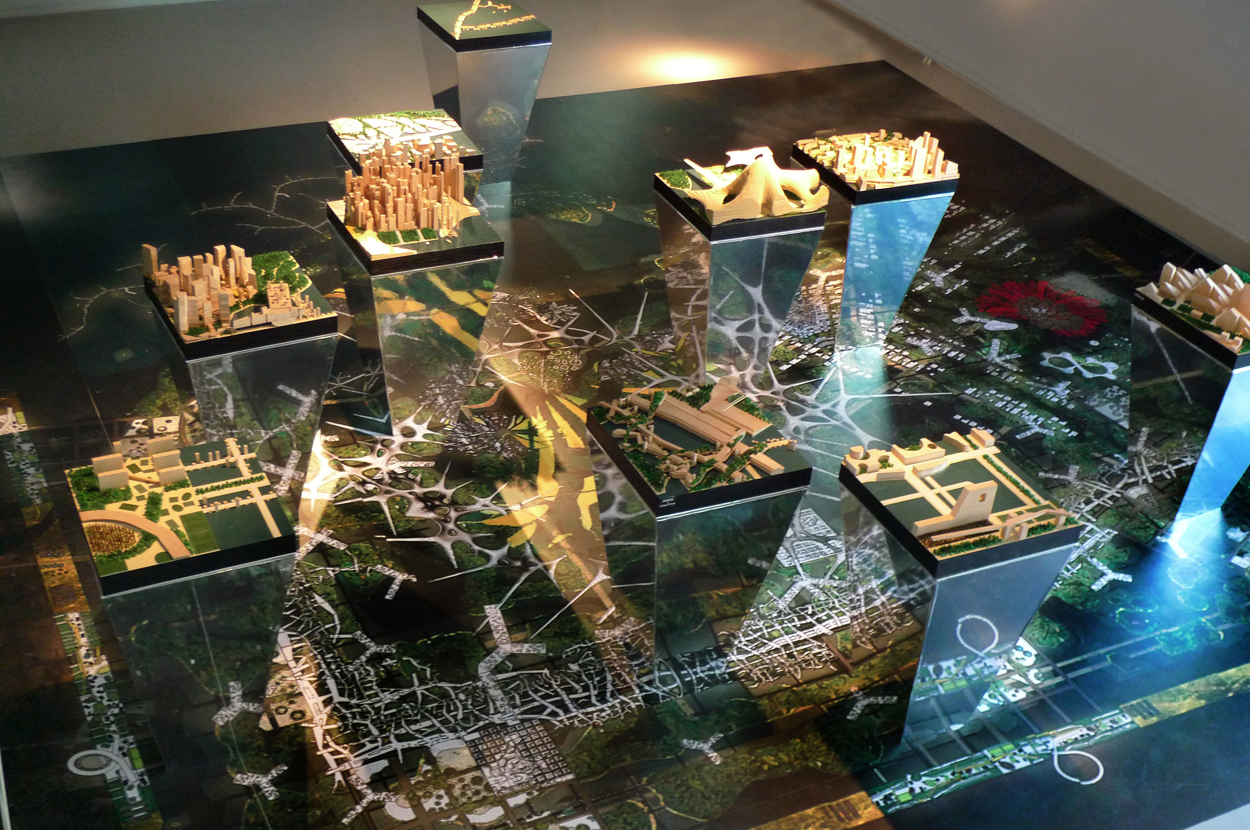
FROM GENERIC TO GENETIC
A CASE STUDY IN EVOLUTIONARY PLANNING
Neville Mars, Dynamic City Foundation
Does it make sense that the new ecocities heralded in Asia and the Middle-east look the same? That they are designed like any generic car city and constructed far from the rest of urban society?
Today sustainability still too often means suburbia with solar panels. Pressure in the boom economies prevents innovation to be integrated or localised. Unfortunately it is precisely here, in countries like China, that entire ecocities are built from scratch and at hyperspeed. This would offer vast opportunities for innovation, yet ironically this approach of top-down overhaul makes China’s cities intrinsically static and their design short-lived. Designed and built overnight these instant cities have trouble incorporating emerging green technologies and responding to new desires and regulations. Outdated as fast as they are erected, China’s short-term investment cycles effectively undermine the long-term visions needed to achieve sustainability. While today’s ecocities are designed on a framework of regulations that effectively prevent the most basic sustainable concepts - like the pedestrian-friendly city - from ever truly happening.
The Dynamic City Foundation (DCF) set out to develop a planning model viable within these harsh conditions. Evolutionary Planning allows a city to respond to market needs without having to abandon its fundamental principles along the way - much like the fractal-like structure of an organically evolving city. We aim to introduce a shift in China’s planning culture from duplication to one of adaptation; a transformation of the Generic City into the Genetic City, where sustainable qualities are ingrained in its core components from conception.
DCF applied this evolutionary planning model to an ambitious new ecocity in China. In a unique collaboration with 5 Dutch and 5 Chinese progressive design companies a long-term growth strategy for Caofeidian was developed; not by designing all at once, but in relay; each team adding to the previous proposal. The result is a simulation of thirty years of sustainable expansion: the city as the product of an accumulation of evolving ideas, able to emulate the complexity and organic logic of a slowly maturing city.
With contributions by Urbanus, MAD, Rocksteady, Powerhouse, MVRDV, BAU, Tsinghua School of Architecture, Urban China, ZUS, and MARS Architects
EXHIBITION AND FORUM: GREEN FROM SCRATCH
BARC aims to explore a process of evolutionary greening for the city of Caofeidian from 2010 to 2040. To achieve this the teams have been asked to expand Caofeidian with 100 000 people in a 3 year period. During a period of ten weeks the 3D file of the cumulative proposal will travel from office to office. The process is documented in order to trace the emergence of a green metropolis over time and understand the qualities of a city as an organic entity. The video footage and the proposals will be visualized in a set of ten videos and presented in ten boxes (image above) and presented at a Dutch Culture House of the Shanghai World Expo 2010.
Neville Mars / DCF
超越中国的建筑规范: 绿色规划的演变
“超越中国的建筑规范”是由动态城市基金会发起的一个颇具抱负的设计/研究协作项目,该项目以有形的案例研究力图拓展可持续发展的中国视野。该方法以其整体性和长期性,模拟规划方案的演变,设计师和政策制定者均可由此借鉴新型可持续发展规划之要领。第一阶段主要是探索与激发灵感。为上海2010世博会荷兰展馆所作,项目汇总了来自荷兰和中国的八支团队,在四个月内集中设计。目的在于把绿色都市重构为一个随时间推移而不断发展的有机体。最终的作品将以引人入胜的视觉方式向世博会观众呈现,并将在专业论坛上接受著名规划师和生态学家的评判。第二阶段是实现。工作团队将在具体地点与地方政府部门密切协作,使“超越中国建筑规范”成为一个演进规划的先导性示范项目。将荷兰设计的理念与荷兰工程公司的见地与技术相结合,力图在可持续规划领域创造出独道的产品。
何新城 / 动态城市基金会
曹妃甸生态城的科幻纪事
何博文 Bowen He / 动态城市基金会(Dynamic City Foundation)
BACKGROUND
背景关键词
Caofeidian 曹妃甸:
北京的重工业都到哪去了?答案就是曹妃甸。除了首钢,曹妃甸正在上马的还有石化工业和将要负担全华北电煤运输的曹妃甸港,而这些大型企业的落户必将带来可观的定居人口,以此为契机,建设一个新兴城市成为一项全国瞩目的新决策。
河北省唐山市南部70公里的渤海岸边,举目四望,是广袤无垠的盐田,农地和荒野地;原住民稀少,以渔业养殖和制盐卫生,历史上是唐朝一名妃子的封邑,这就是建设中的曹妃甸新城所在地。
曹妃甸新区将近1500平方公里,堪比深圳;而其中大约70-80平方公里的土地(一部分将在未来的填海工程中产生),将会集中建设一个新城市——曹妃甸国际生态城。
Eco-city 生态城:
建设生态低碳社会,是全球的诉求,也是中国政府的既定方针。而在曹妃甸,这块以后将重工业林立的滩涂盐碱地,正野心勃勃地打造一座定位领先全球的生态新城市;
何为生态?目前并没有权威的定义;同样,生态城也难以拥有明确而权威的定义;但我们心中都有各自对“生态”的疑问或者信念;正因为没有定义,才赋予我们这个项目丰富的实验空间和探索空间。
Generic city“ 庸常城市”(又译“广普城市”;“通属城市”):
“Generic City” 是库哈斯广为人知的理论,其核心就是市场经济模式下驱动的普通城市发展模式。此论之所以著名,只因普通;一是普通到一旦你要讲“特殊”的事情都得拿这个“普通”来当参照系;二是他能将林林总总的纷繁复杂的“普通”一言以蔽之;因此几乎所有关于当代城市发展的模式都不约而同地引用此论作为某种开篇,此处我们也不例外。
而在其背后的若干态度:一是对这种强大模式的无奈却积极的承认——市场经济到哪,庸常城市就能到哪!;二是对这种模式的戏讽,解读,批判的无休止的残念;三是不可浇灭的意欲突破的冲动;
Genetic city “进化城市”
“Genetic City”作为BARC项目发起人Neville Mars 提出的概念,词源上取自基因(gene),同时又与generic city 对仗:意在顺应“Generic City庸常城市”市场驱动模式的大前提下,强调城市是作为一代代人不断建设的结果,而非某一代人或某一群人在某一刻的决定或设计这一城市进化观念。
也正因为此,十个团队分期接力设计的策划,正为了模拟城市在一代代人的观念引导下的渐进式进化发展,虽然每个设计团队都来自一个时代,但我们都有不同的背景,我们必须以我们的预测与远见,以各自设定的未来时代为准,做出承前启后的规划设计;而这种对未来的代入和假设,无异于科幻作者们所常做的努力。
BARC —超越中国建筑规范
建设一个既生态又与众不同的新城市,我们遇到的阻力是什么?为何新城建设最终总是流于庸常城市?我们为何最终总是无法得到我们想要的?
建筑规范(这里也同样泛指包括规划法规等)是对城市建设做定性和定量控制的具有一定强制力的法律法规。首先,规范的内容当中,往往以定量的方式,对开发进行限制,以定性的方式对土地使用方式进行预设;其次,作为自上而下的城市规划和管理方式,从中央延伸到地方;第三,往往会以较为模式化标准化的系统来对待城市。尤其突出的就是控制性详细规划,这种很大程度上借鉴于美制Zoning的城市规划方式,很大程度上成了庸常城市的温床,其结果就是:在商业利益和政策制约的双重博弈下,设计的取值往往趋于双方利益的最大化,因此各项取值趋于唯一,从而造就了千城一面。更为人诟病的莫过于,规范和法规的所谓制约,往往并没有确凿的理性依据,而多为“拍脑袋”的随机结果;
因此,为了实现某些生态设计意图;例如,提高密度,增加道路效用/宽度比,实现混合功能等,都不得不与现行规范产生冲突;因此,为了提出更具有前瞻性的生态城设计观念,我们首先需要突破规范——Beyond the Architectural Regulation of China
Start from Scratch 从头绿:
从头绿,就是从无到绿,我们面对的是一张白纸,我们需要的是设计整个系统,而不仅是添砖加瓦。
现状条件对于设计师而言,往往是依据而不是制约;对于没有现状限制的条件,才是设计师真正的挑战;
如果说,在一个原本成熟的城市基础上,逐步改进以实现高效紧凑的生态城市,会是有所依凭或者说相对容易的方式;那么,在一片荒芜的盐碱滩上从一无所有到打造一座理想的生态新城,就显得更加富有挑战性了。

~ Without integrated planning a collection of well designed sustainable buildings can still amount to a poorly operating, ultimately unsustainable city. ~ Neville Mars, Dynamic City Foundation
WHY: Even today no over-arching, holistic or integrated green planning model exists in the world. While, particularly in boom economies such as China, the shortcomings of existing green planning models are quickly coming to the surface. Unable to adapt to changing needs China’s new cities are outdated the day of completion. Not surprisingly, as China’s young society rapidly creates many new demands and desires, the aggressively competitive market leaves designers no time to produce long-term strategies or think in flexible solutions. Sustainability however, can only be conceived, achieved and be paid for on the long term.
Project BARC aims to offer an antidote by inviting 10 progressive design offices to step by step imagine a visionary plan for Caofeidian Ecocity - one of the most prominent new green cities in China. Starting from scratch Project BARC simulates the growth of this city’s aspired high-speed development process for the period 2010 till 2040. One after the other, for 3 year cycles each team proposes an urban expansion of 100 000 people to achieve a city of 1 million people for the year 2040. For every three-year growth cycle DCF has prescribed different ‘hopes and hazards’ that are likely to impact urbanization - from rising sea levels, to a rise in wind power, etc. As the urban expansion proposals add up, an accelerated urbanization process becomes manifest. We can see how layers of designed solutions unfold and how each step impacts the next and shaping the evolution of a sustainable city.
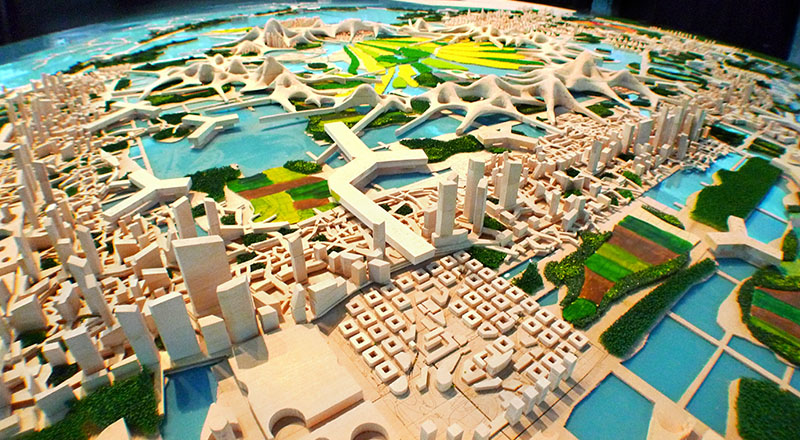
HOW: The second hurdle for sustainability involves regulations. Urban planning codes have not yet been updated to deal with the broad implications of contemporary forms of urban sustainability. In previous research it became clear that in China, working within the official planning regulations effectively makes it impossible to design a sustainable city. Apart from inadvertently promoting sprawl, the regulations actually prevent innovation. The building off-set rules produce cities that are hostile to pedestrians. As a result, although green buildings and technologies are welcomed and often good planning is attempted, the city is unable to break away from inefficiency, congestion and pollution. This situation is particularly harsh in China, yet globally outdated regulations are slowing down the innovation of green planning and prevent much needed transition beyond basic solar voltaics or wastewater management.
Project BARC (Beyond Architectural Regulations in China) temporarily abandons short-term restrictions and regulations to give room for green solutions beyond the current norm. The goal is to collectively generate an ideal master plan. Ideal, not simply in terms of energy efficiency, but as a future living environment. Apart from revealing the limits of current policies, visualizing what the green city could ultimately entail serves a number of practical purposes; an over-arching vision for the future allows engineers and designers working in this field to streamline their efforts towards a common goal. At the same time it can show policymakers and consumers what an evolutionary approach to planning today could offer residents of a green city tomorrow. As such, the proposed city for 2040 is both a pilot project to be realized in Caofeidian and a tool to discuss how to move towards real urban sustainability in China.
展示: 更大的城市让生活更美好
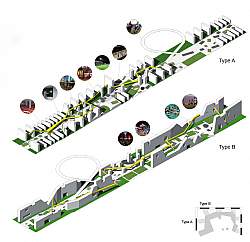
记录设计过程对于项目是非常关键。展示也将尽力地切合规划原作。考虑到知识更替的速度,对话交流与实际制作过程才是重点。初步的讨论和设计准备可在动态城市基金会的网络平台上被追踪。第一阶段——集思广益,草图素描及设计产生——将在动态城市基金会北京工作室的蓝屏房间进行。整个过程将通过DV详细记录,设计师被置于他们自己方案的渲染中,并讲述所设计城市背后的概念。最终的视频将以动画快进的形式,展现一个城市,如何从 2010年到2050年规模扩大了两倍;即一个绿色都市兴起的由来。
超越温室玻璃球
或者说,规划一定要大
绿色都市终于挤进了世界议程。在中东和中国,首批零碳城市的方案已经完成;所有大项目也不再局限于绿色建筑单体,而旨在创造闭合的环境体系。在野心和技术的推动下,这些零碳城市都是自上而下式新城规划的极品。但世界上的城市化进程——尤其是发展中国家——极少是建新城的产物,而是郊区蔓生或草根城市化的结果。尽管绿色新城的效率尚可,但它们与外界隔绝、不灵活、社会性被扭曲而且高度依赖于私家车,有些只能按特殊定义才勉强算得上环保。这些项目暴露的是——我们仍然缺少能应对“市场趋动型城市化”的划,同时证明了可持续规划固有的复杂性:
- 只有绿色都市才够大,才能形成闭合的综合体系。
- 要成就规模,绿色都市必须在现存的城市中心基础上发展、演变。
- 若要绿色都市的效率超过绿色插件之和, 则要与周围、社会及文化环境发生相当细密的关联。
中国规范之噪 或者说
为什么规划需要灵活性
关于全球的可持续性,全世界都既焦虑又期待地看向中国。既然中国城市化的热潮还将持续三十年,一个着眼于未来的规划必然会让中国大大受益。中国很愿意照搬来自西方的绿色模式,但实际上只是在做绿色的表面文章。首先,世界上没有可持续规划的现成模式,也没有能适应中国高速城市化进程的模式。其次,中国的规划编制和规划文化是以理顺疯狂的建设秩序为目的,这从根本上抑制了顾全大局的方法的产生。近来,一些最先进的国外规划都因为与中国情况脱节,最终沦为了概念废品。同时,更为务实的技术升级让原本低效的城市系统和本地的生活方式得以持续。此番分离基本上让中式西式的努力互相抵消,只有以下情形有可能解决问题:
- 形成可持续规划的远见:兼顾市场驱动性且着眼于未来。
- 能在规划完成后进一步演变,能适应中国建设速度的巨大压力和中国的规划文化。
- 有超越中国建筑规范的意愿
规划快进
或者说,模拟演变的扩张
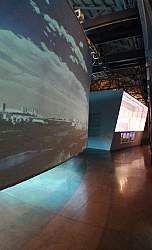
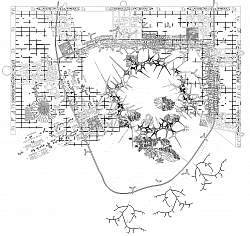
规划快进 或者说,模拟演变的扩张为了达到高度的设计整合,项目必须跟得上中国发展的加速度。“超越中国建筑规范”项目以动态城市基金会对中国闪电城市化数年研究的结果为基础。动态城市基金会认为城市是一个有机整体,在自上而下和自下而上的力量的碰撞的推动下不断发展演变。要对有机生长有效地回应,必须长期在各个层面有序地努力——从国家规定、地方网络、到街区并最终到终端用户才有可能实现。因此项目应该追踪规划不同层面的决策。这有一个矛盾,那就是在短短四个月的时间里,项目需要分析数十年、持续规划决策的叠加效应。为了实现目标,我们根据中国的五年经济规划周期设计了一个具体的研究方法来模拟未来四十年的状况。我们邀请了八个设计团队,四个来自荷兰,四个来自国,他们将为同一个城市做接力设计。每个团队负责在上一团队的规划之上开发下一个五年规划。具体的设计在workshop中完成。每个团队有一周的准备时间,另有两天用于现场估,并于一周后完成。他们将在限期内的最后一天把自己的设想方案交给下一个五年计划的负责团队。项目完成后,将展现从2010年至2050年四十年间长期而具体的规划,以及规划本身加速发展的模拟。
Moderators:
Adrian Hornsby , Neville Mars, Koon Wee

Check for PART 2 of the Green From Scratch forum in the NAi in Rotterdam, Spring 2011 and the accompanying publication!
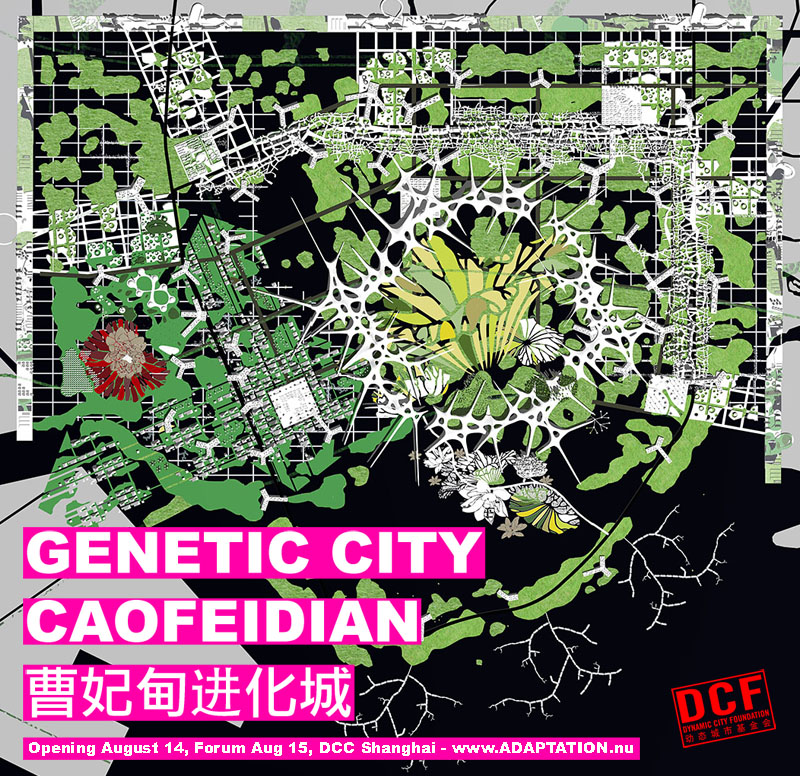
This project has been made possible with the generous support of the following institutions:
Owned by neville mars / Added by neville mars / 16.1 years ago / 93344 hits / 32 hours view time
Tags
Latest Entries
-
00AA MAG
-
casla
-
Genetic City Caofeidian in Casla
-
updates Master plan Caofeidian
-
Green From Scratch Forum and ceremony
-
Trailer Caofeidian Genetic City - BARC 5 min
Contribute
Login to post an entry to this node.
